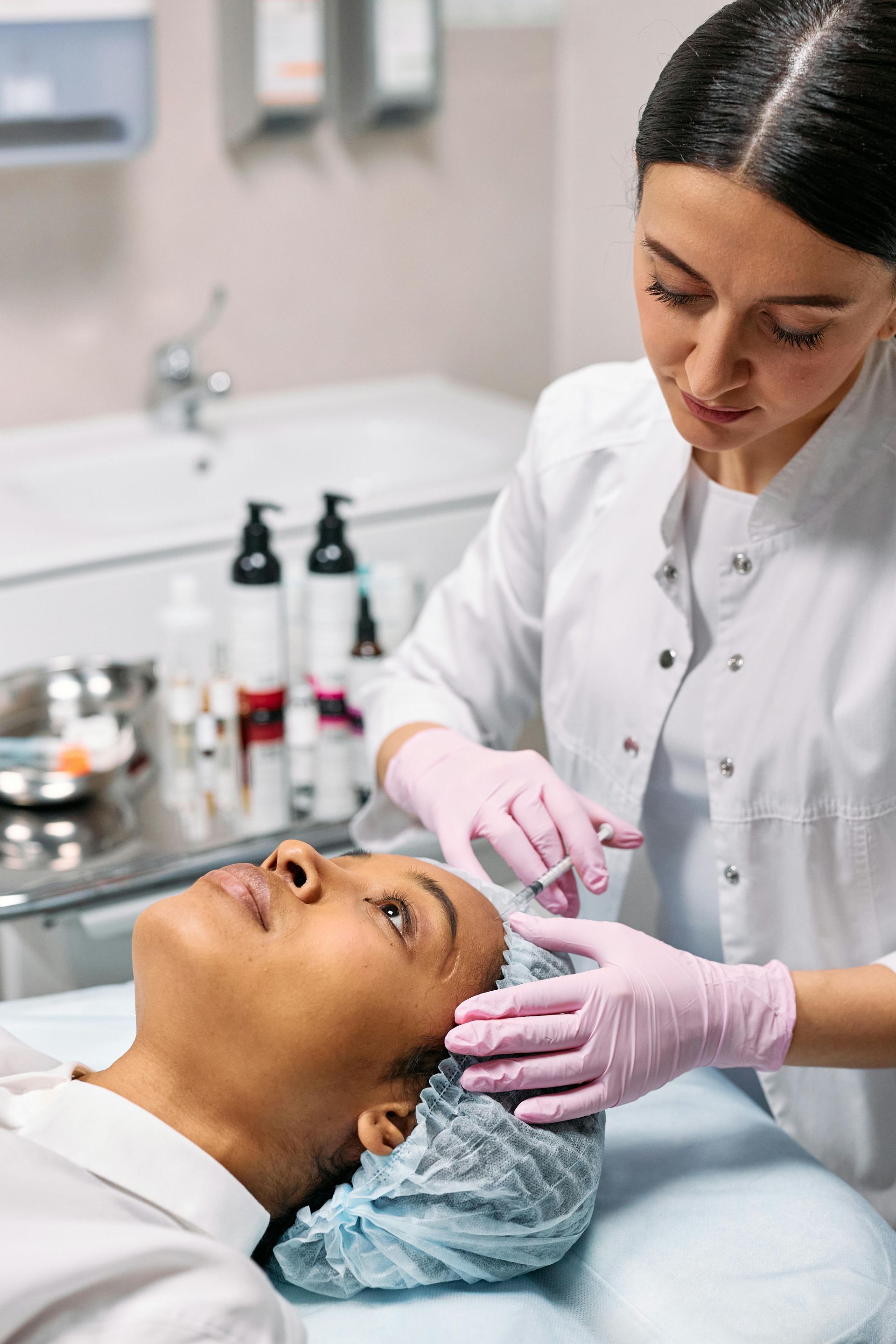Significant weight loss represents a tremendous achievement that transforms your health, energy, and quality of life. Whether you've reached your goal through diet and exercise, bariatric surgery, or a combination of approaches, you've accomplished something remarkable that took discipline, commitment, and perseverance. However, many patients discover that substantial weight loss creates a new challenge: excess skin that doesn't conform to their new body contours. This loose, hanging skin can obscure the results of your hard work and create both physical discomfort and emotional frustration.
Body contouring surgery addresses these concerns by removing excess skin and reshaping your body to reflect the weight you've lost. These procedures aren't about weight loss itself, they're about revealing the body transformation you've already achieved. Understanding when you're ready for body contouring, what procedures might benefit you, and what realistic results look like helps you make informed decisions about this final step in your weight loss journey.
1. Understanding When You're Ready for Body Contouring Surgery
Timing matters significantly for body contouring procedures. Your body needs adequate time to stabilize after major weight loss before surgical intervention makes sense. Most plastic surgeons recommend waiting until your weight has remained stable for at least six months to a year. This stability ensures that your surgical results won't be compromised by continued weight fluctuation. If you're still losing weight actively, additional skin contraction may occur naturally, potentially changing the amount of excess tissue requiring removal.
Medical readiness extends beyond weight stability. If you underwent bariatric surgery, your body has experienced significant metabolic and nutritional changes that require time to normalize. Work closely with your bariatric surgeon or primary care physician to ensure your nutritional markers, vitamin levels, and overall health status can support the demands of additional surgery and healing. Deficiencies in protein, iron, or essential vitamins can compromise wound healing and increase complication risks, making medical optimization crucial before proceeding.
Psychological readiness also plays an important role in successful outcomes. The journey of major weight loss often involves complex emotions, and some patients benefit from counseling or support groups to process the physical and emotional changes they've experienced. Body contouring brings its own recovery challenges, scarring considerations, and adjustment period. Patients who approach surgery with realistic expectations, understanding of the trade-offs between loose skin and surgical scars, and strong support systems tend to have more satisfying experiences.

Consider your life circumstances as well. Body contouring procedures typically require several weeks of limited activity, assistance with daily tasks during early recovery, and time off work depending on the extent of surgery. If you're planning significant life events like moving, changing jobs, getting married, or starting a family, timing your surgery around these commitments ensures you can dedicate proper attention to healing. The investment of time, energy, and resources required for optimal recovery deserves consideration when planning your procedure timing.
2. Common Body Contouring Procedures After Weight Loss
Body contouring encompasses multiple procedures that can be performed individually or combined based on your specific concerns and surgical tolerance. The abdomen typically experiences significant excess skin after major weight loss, making tummy tuck (abdominoplasty) one of the most commonly requested procedures. This surgery removes loose abdominal skin and tightens separated abdominal muscles, creating a firmer, flatter contour. For patients with extensive skin laxity, an extended or circumferential tummy tuck addresses tissue around the sides and back as well.
Breast changes frequently accompany major weight loss, with many patients experiencing deflation, sagging, and loss of volume. Breast lift (mastopexy) repositions breast tissue to a more youthful position on the chest wall, removes excess skin, and reshapes the breasts for improved contour. Some patients benefit from combining a breast lift with augmentation using implants or fat transfer to restore lost volume. Men who've experienced significant weight loss may develop excess breast tissue that doesn't resolve with diet and exercise, a condition addressed through male breast reduction (gynecomastia surgery).
The upper arms often develop loose, hanging skin that extends from the shoulder to the elbow, commonly called "bat wings." Arm lift (brachioplasty) removes this excess tissue and tightens the underlying supportive structures, though it does create a scar along the inner arm. Similar concerns affect the thighs, where excess skin can cause chafing, difficulty with clothing fit, and appearance concerns. Thigh lift procedures address the inner thighs, outer thighs, or both, depending on where excess tissue is concentrated.
The lower body lift represents a more comprehensive approach that addresses multiple areas in a single operation. This procedure typically combines a tummy tuck with lifting of the buttocks, hips, and outer thighs by removing a circumferential band of excess skin around the body's midsection. While more extensive than individual procedures, a lower body lift efficiently addresses connected areas of tissue laxity with a single recovery period. Your surgeon will help determine whether staged individual procedures or a combined approach best suits your anatomy and goals.
3. Realistic Expectations About Scarring and Results
Understanding the relationship between excess skin removal and surgical scarring represents a critical component of informed decision making. Body contouring procedures inherently create scars because removing significant amounts of tissue requires substantial incisions. These scars are permanent, though they typically fade considerably over time and can often be positioned to remain hidden under most clothing and swimwear. The trade-off between loose, hanging skin and well-placed surgical scars is personal, and only you can determine what represents improvement for your body and confidence.
Scar placement follows natural body contours and clothing lines when possible. Tummy tuck scars typically run low across the lower abdomen, easily concealed under underwear and swimsuit bottoms. Arm lift scars extend along the inner arm from elbow toward armpit, visible when arms are raised but less noticeable when arms rest at your sides. Thigh lift scars may be placed in the groin crease, along the inner thigh, or both, depending on the surgical technique required for your specific concerns. Your surgeon will discuss expected scar locations and show you examples during consultation so you can visualize the anticipated outcome.
Scar healing varies significantly between individuals based on genetics, skin type, age, and how carefully you follow post-operative care instructions. Most scars appear red, raised, and prominent during the first few months after surgery before gradually fading and flattening over 12 to 18 months. Protecting scars from sun exposure, following your surgeon's scar care protocol, and avoiding activities that create tension on healing incisions all contribute to optimal scar maturation. Some patients choose to use silicone sheets, scar gels, or other treatments to support the healing process, though genetic factors ultimately determine your individual scarring pattern.

Results improve continuously over many months as swelling resolves, tissues settle into their new positions, and scars mature. Immediately after surgery, you'll experience significant swelling that temporarily obscures your results. This swelling diminishes gradually, with most patients seeing substantial improvement by three months and near-final results by six to nine months post-operatively. Maintaining stable weight, following a healthy lifestyle, and protecting your skin from excessive sun exposure all contribute to preserving your surgical results long-term.
4. Recovery Timeline and Physical Expectations
Recovery from body contouring surgery demands more time and assistance than many patients initially anticipate. The first week typically proves most challenging, with significant soreness, limited mobility, and reliance on pain medication to manage discomfort. Most patients require help with basic activities like meal preparation, household tasks, and personal care during this initial period. Arranging for assistance before surgery, whether from family members, friends, or hired help, ensures you can focus on rest and healing without stress about daily responsibilities.
Activity restrictions vary by procedure but generally include avoiding heavy lifting, strenuous exercise, and activities that create tension on incision sites for several weeks. Light walking typically begins within days of surgery to promote circulation and prevent blood clots, gradually increasing as tolerance improves. Most patients return to desk work within two to three weeks, though jobs requiring physical labor necessitate longer recovery periods of four to six weeks or more. Your surgeon will provide specific guidelines based on the procedures performed and your individual healing progress.
Compression garments play a crucial role in recovery by supporting healing tissues, minimizing swelling, and helping skin conform to new body contours. You'll wear these specialized garments continuously for several weeks, then during daytime hours for additional weeks as directed by your surgeon. While compression garments can feel tight and uncomfortable initially, they significantly contribute to optimal results and reduced recovery discomfort. Following garment recommendations carefully helps achieve the smooth, even contours you're seeking.
Physical sensations during recovery include numbness, tingling, tightness, and intermittent sharp pains as nerves regenerate and heal. These sensations are normal aspects of the healing process and typically improve gradually over weeks to months. Some areas may experience prolonged or permanent altered sensation, particularly in regions where significant tissue was removed or repositioned. Discussing sensation changes with your surgeon during consultation helps set appropriate expectations about what you might experience during recovery.
5. Maintaining Your Body Contouring Results Long-Term
Body contouring surgery removes excess skin permanently, but it doesn't prevent future weight gain or the natural aging process from affecting your results. Maintaining stable weight represents the single most important factor in preserving your surgical outcomes. Significant weight gain after body contouring stretches the remaining skin and can recreate some of the laxity you worked to eliminate. Similarly, major weight loss after surgery may create new areas of excess skin, though typically less dramatically than after your initial weight loss journey.
Consistent exercise routines that include both cardiovascular activity and strength training support long-term results by maintaining muscle tone, managing weight, and promoting overall health. Building lean muscle mass helps fill out your body contours naturally and creates definition that enhances your surgical improvements. Focus on sustainable fitness habits you can maintain permanently rather than extreme approaches that prove difficult to sustain over time. Your improved body contours often provide motivation to maintain the healthy lifestyle that made surgery possible.
Nutrition remains fundamentally important after body contouring, just as it was during your weight loss journey. Adequate protein intake supports ongoing tissue health and wound healing long after surgery. Staying well-hydrated, consuming plenty of fruits and vegetables, and limiting processed foods all contribute to maintaining your results and overall wellness. If you worked with a nutritionist during weight loss, continuing that relationship provides ongoing support and accountability for maintaining your achievements.
Skin care helps preserve the quality and appearance of your results as you age. Protecting your skin from excessive sun exposure prevents premature aging and helps surgical scars fade optimally. Moisturizing regularly maintains skin elasticity and hydration. If you smoke, quitting permanently protects not only your surgical results but your overall health. The skin remaining after body contouring has already been stretched significantly, making it more susceptible to the effects of smoking, sun damage, and inadequate hydration.
Conclusion
Body contouring surgery represents the culmination of your weight loss achievement, removing the excess skin that prevents you from fully enjoying your transformed body. These procedures require careful consideration of timing, realistic expectations about scarring, commitment to recovery protocols, and dedication to maintaining results through continued healthy habits. The decision to pursue body contouring is deeply personal, balancing the benefits of improved contours against surgical scars, recovery demands, and financial investment.
At 5280 Plastic Surgery in Westminster, Colorado, board-certified plastic surgeon Dr. John Samas specializes in body contouring procedures that help post-weight loss patients achieve the body shape their hard work deserves. Serving patients throughout the Denver metro area, including Broomfield, Aurora, Lakewood, Thornton, and Arvada, the practice provides comprehensive consultations to evaluate your unique situation and develop a surgical plan tailored to your anatomy and goals. If you've achieved significant weight loss and are ready to explore how body contouring might complete your transformation, contact 5280 Plastic Surgery to schedule your consultation.




